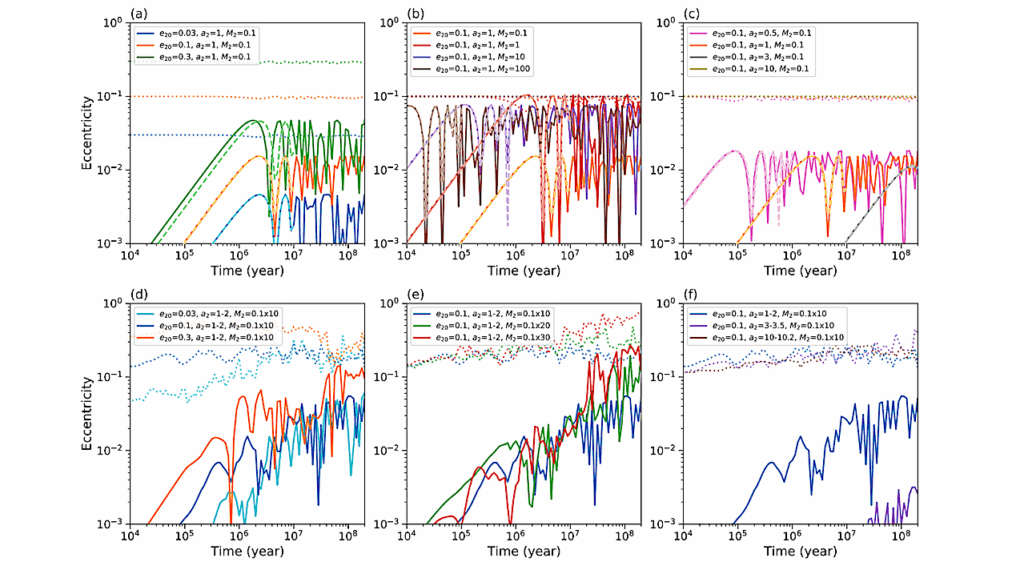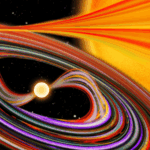Now Reading: An Earthlike Density For The Temperate Earth-sized Planet GJ 12 b
-
01
An Earthlike Density For The Temperate Earth-sized Planet GJ 12 b
An Earthlike Density For The Temperate Earth-sized Planet GJ 12 b


The mass and radius of our two models for GJ 12 b (circular and eccentric orbits) compared to various composition models from L. Zeng et al. (2019), as well as a steam atmosphere model from M. Turbet et al. (2020) and an H/He atmospheric model from M. C. Nixon & N. Madhusudhan (2021) and M. C. Nixon et al. (2024). The star corresponding to the eccentric-orbit model has been shifted slightly upward so that the errors of the two points are distinguishable. We note that the 50% water model, which is from L. Zeng et al. (2019), assumes a planet temperature of 300 K, which is very close to the actual equilibrium temperature of this planet. — The Astronomical Journal
While JWST has provided us with the opportunity to probe the atmospheres of potentially habitable planets, observations of the TRAPPIST-1 system have shown us that active stars severely complicate efforts at studying their planets.
GJ 12 b is a newly discovered temperate (Teq ≈ 300 K), Earth-sized (Rp = 0.96 ± 0.05 R⊕) planet orbiting an inactive M dwarf that might be a good alternate to the TRAPPIST-1 planets for atmospheric characterization. In this paper, we use MAROON-X radial velocities to measure a mass of 0.70 ± 0.10 M⊕ for GJ 12 b.
We also recover a planetary eccentricity of 0.24, but there is no strong evidence that the planet has an eccentric orbit. GJ 12 b’s mass results in a planetary density comparable to or less dense than that of Earth, possibly indicating the presence of water or a low bulk iron mass fraction.
With its low mass, GJ 12 b is likely within reach of JWST transmission spectroscopy observations, making it an excellent target for determining the location of the cosmic shoreline. Its low mass may mean that the planet could have trouble retaining its primary atmosphere during the star’s active pre-main-sequence phase.
However, if it has a heightened eccentricity, it may be able to sustain a secondary atmosphere through tidally induced volcanism.
An Earthlike Density for the Temperate Earth-sized Planet GJ 12 b, The Astronomical Journal (open access)
Astrobiology,
Stay Informed With the Latest & Most Important News
Previous Post
Next Post
-
 012024 in Review: Highlights from NASA in Silicon Valley
012024 in Review: Highlights from NASA in Silicon Valley -
 02Panasonic Leica Summilux DG 15mm f/1.7 ASPH review
02Panasonic Leica Summilux DG 15mm f/1.7 ASPH review -
 03How New NASA, India Earth Satellite NISAR Will See Earth
03How New NASA, India Earth Satellite NISAR Will See Earth -
 04And Thus Begins A New Year For Life On Earth
04And Thus Begins A New Year For Life On Earth -
 05Astronomy Activation Ambassadors: A New Era
05Astronomy Activation Ambassadors: A New Era -
06SpaceX launch surge helps set new global launch record in 2024
-
 07Space Force plans new ‘Futures Command’ amid pressure to speed up modernization
07Space Force plans new ‘Futures Command’ amid pressure to speed up modernization





















